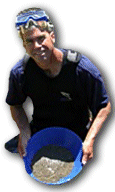
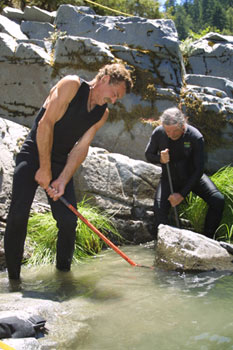
This entire group, including myself, was comprised of 22 people. We started with 13 participants, but my two assistants (Craig Colt & Shawn Higbee) were there to help coordinate the activity. George and Heidi Hurteau contributed to a lot of the dredging activity using their own dredge. Scott Langston was already present with his personal dredge when we started, so we invited him into the group project. And a real strong member named Leif (we call him Hercules) from Sweden also jumped in to give us a hand. All in all, we used a 3-inch dredge (to start less-experienced participants), four 4-inchers, and a 5-inch dredge. It was a pretty sizable project!
Since the area was so accessible for our group, we decided to sample one of the areas along the Salmon River. We had heard that there had been some successful dredging there in the past, so we were hoping to get in on a piece of that action.
We started the week sampling the upper end of that area, just below the set of rapids. It was a good place to allow our more-experienced participants to begin the serious sampling activity, while I could start working at getting less-experienced helpers comfortably into the water.
Hercules (Leif Sollier) at work!
In supervising these group dredging projects, I am finding that my biggest personal challenge is to balance the need to get an effective sampling activity going as quickly as possible (followed by some volume production to accumulate some gold to split off at the end of the week!), while also helping less-experienced helpers get through the initial stages of panic and fear. It also takes some time and effort to groove more experienced participants into the finer points of underwater production techniques.
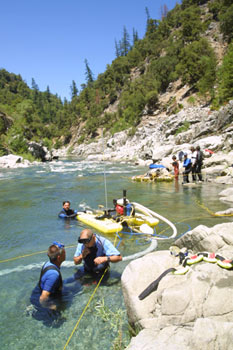
In the foreground, Dave Mack is giving direction to New 49’er member, Fred Zajac, who participated in this group mining project.
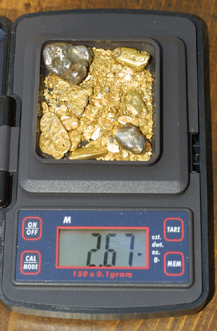
Total recover for the week weighed in at 2.5 ounces. Half of the weight was in nuggets!
It took me the first few days to size everyone up so that I knew how I could effectively (and safely) utilize the human resources to get some good sample holes completed. As the less-experienced helpers gained more experience, we moved them further out into the river. And it was not long before, as a team, we started to figure out where the gold is (and where it isn’t) on that portion of the Salmon River.
By the end of the 2nd day, even though we were accumulating some flood gold in our concentrates, we had pretty-much established that the area just below the rapids had been dredged before – probably back in the late 1980’s. Just about all our sample holes were finding loose cobbles and boulders (with light sand or silt around them) along the bedrock.
Since Scott Langston’s dredge was in good hard-packed streambed material about 120-yards behind us, and he was getting a pretty good showing of gold there, during the 2nd day, we broke out the new Griphoist (pretty-serious hand-operated rock winch) and invested several team mates there to get Scott’s sample hole enlarged. That proved to be a smart move, because Scott’s dredge immediately began recovering good gold (with nuggets) as we got down to bedrock through about 3 to 4 feet of material.
The success on Scott’s dredge prompted us to immediately drop all the dredges back down the river about 100 yards, and we started a whole new series of samples on the 3rd day, all which were going down into hard-packed material – meaning that no-one had been there before us with a dredge. This was good!
While we were getting pretty good gold out of each sample, by the 4th day, we established that the gold was richer towards the other side of the river (on the side away from the road). This caused us to abandon two excavations and start new ones further upstream. Early success in these holes motivated us to rig up for more serious winching on the 5th day. I have a 4-ton electric winch mounted on the back of my flatbed truck. We set my truck up
on the side of the road and double-pullied back to increase pulling power. Then, after some discussion about winching techniques, by half-way through the 5th day, participants were slinging boulders like they had been doing it for years.
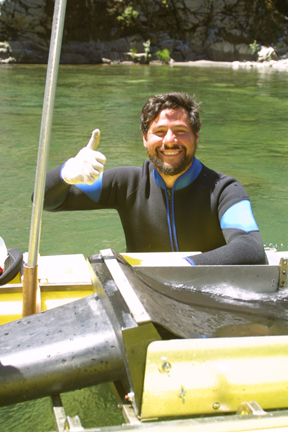
Vincent Xavier, from San Diego, gives his “thumbs up” on his day’s mining experience.
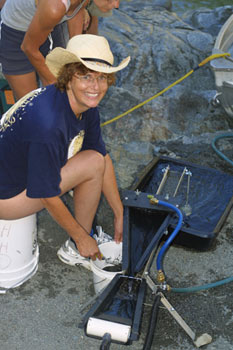
Marge Strutt gives her approving smile of the day’s clean up.
By the end of the 5th day, our accumulated concentrates for the week were looking pretty good. We had pulled several gold nuggets (from small up to 2.5 dwts), and we had pulled two platinum nuggets (the larger one weighing in at 8.5 dwts!). Other than a few less-experienced dredgers that I was continuing to work with near the bank, all of the participants were taking shifts out in the deeper-water holes. We were operating four dredges in gold, and winching rocks using two winches.
I’ll say that the 5th day was one of the most hectic and stressful days I’ve had in a long time. That is a lot of action to keep track of! My main concern was that no-one got hurt. I ran and swam around non-stop trying to stay on top of everything. As it turned out, the participants had everything under control.
On the 6th day, after a short talk about safety and teamwork, we set out to work knowing that this would be the only real full production-day of the week. By this time, group-participants were doing nearly all the work like a well-seasoned crew. We had established a pay-streak through sampling. Everyone understood where the gold was coming from and how we found it. The participants set up all the winch rigging, did all the start-up routines with the dredges, worked out the dive teams, and were into production as if they had been working together for years.
I spent most of the 6th day sitting on a rock-perch calmly keeping a watchful eye over the whole program. It was quite impressive. Boulders were being winched simultaneously from both sides of the river. Four dredges pumped material non-stop, with shifts changing one person at a time. Signals were given flawlessly. And I proudly watched it all unfold, in awe that 21 people could be brought together and shaped into such a fine team in less than a week. I was also already feeling sad that just as the team was really pulling together, the project would end soon. We recovered 4 or 5 nice gold nuggets on the 6th day, the largest being 1/4-ounce. There was lots of excitement and team-pride at what we had accomplished.
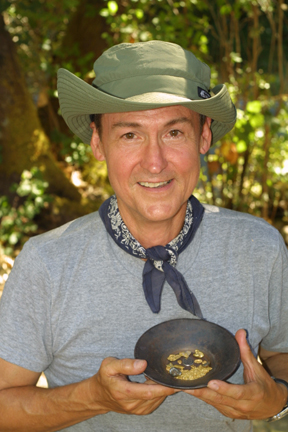
Scott Langston proudly holds the week’s 2.5 ounces recovery from the dredging project.
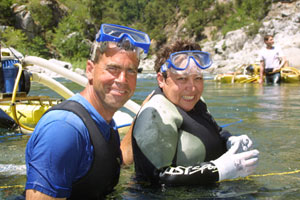
Dave Mack and Eve Kihn take a moment from the training to smile for the camera.
I spent most of the 6th day sitting on a rock-perch calmly keeping a watchful eye over the whole program. It was quite impressive. Boulders were being winched simultaneously from both banks. Four dredges pumped material non-stop, with shifts changing one person at a time. Signals were given flawlessly. And I proudly watched it all unfold, in awe that 21 people could be brought together and shaped into such a fine team in less than a week. I was also already feeling sad that just as the team was really pulling together, the project would end soon. We recovered 4 or 5 nice gold nuggets on the 6th day, the largest being 1/4-ounce. There was lots of excitement and team-pride at what we had accomplished.
We spent the 7th day processing all the concentrates from the week, and pulling most of the dredging and winching gear off the river. Total recovery for the week weighed in at 2.5 ounces. Half of the weight was in nuggets. Group participants performed all the final clean-up steps, and we split the gold. By unanimous consent, the participants drew chances on the 10 largest nuggets. Everyone was happy with the final result. It was a good week!
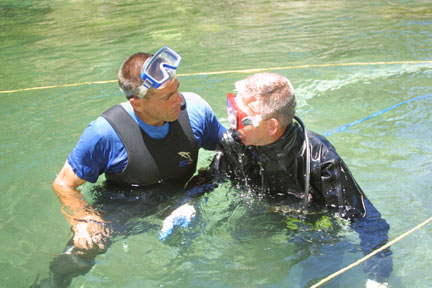
Ryck Rowan, from Washington, is focused on the pointers Dave Mack is giving from his years of dredging experience.
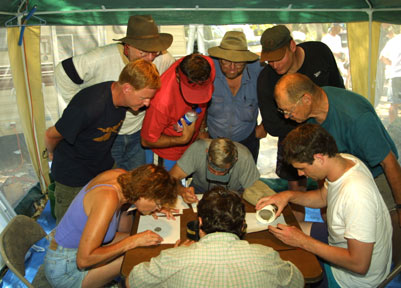
Team members closely watch the final clean-up activities of the week’s dredging.





